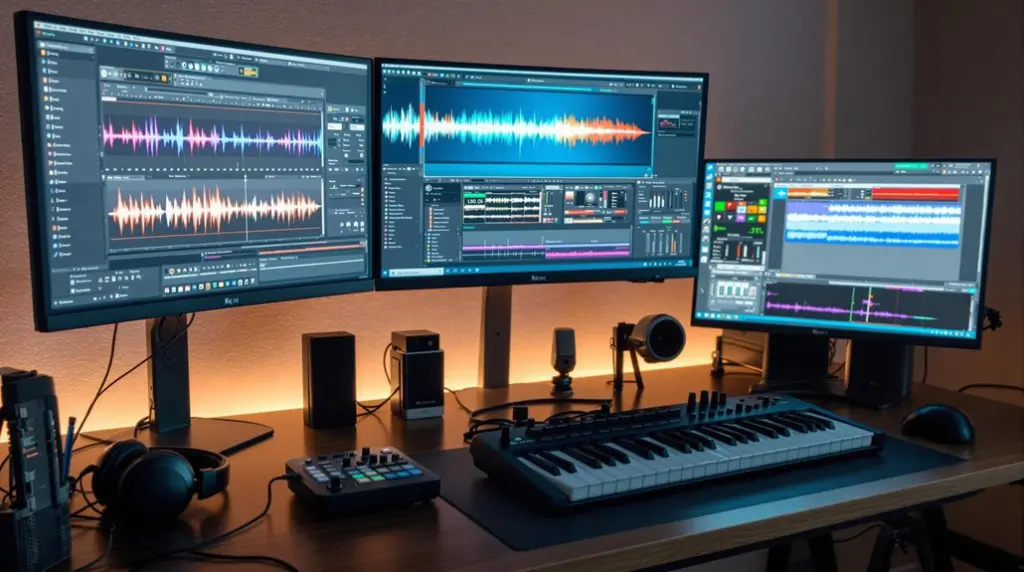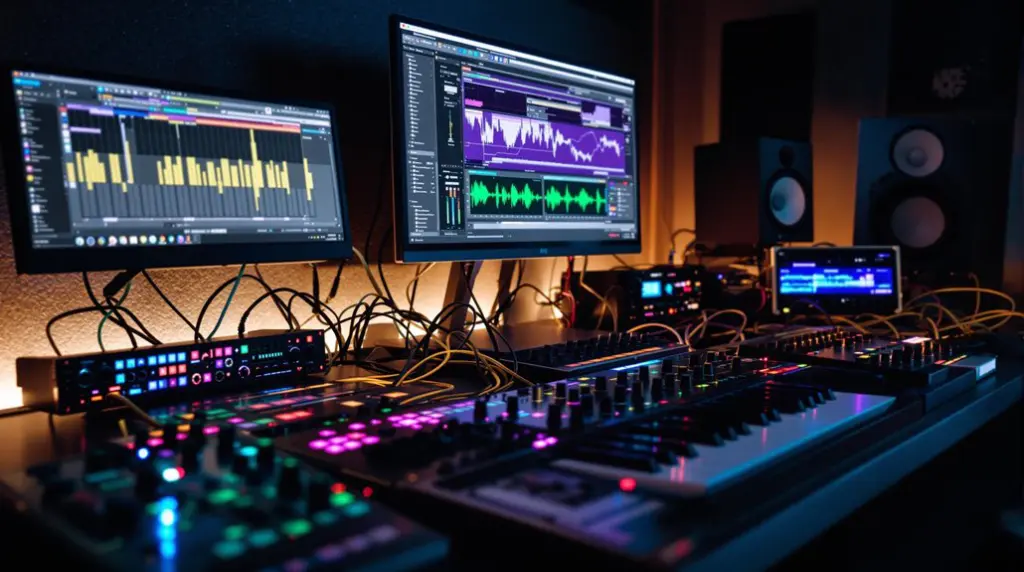The Access Virus C stands out with its notable features: a robust polyphony of 32 voices, dual filter architecture for intricate sound design, and an expanded modulation matrix enhancing creative flexibility. Its synthesis architecture includes classic oscillators and FM modes, combined with 1,136 patches, ensuring a rich sound palette. The durable build quality, intuitive user interface with a redesigned front panel, and dense LED visualization promote efficient workflow. Additionally, extensive effects and vocoder capabilities further enhance its versatility. Positioned strong amidst market competition, continuous software updates and backward compatibility reinforce its esteemed status. Discover the depth of each feature further below.
Key Takeaways
- The Access Virus C offers up to 32 voices of polyphony for intricate sound design.
- Enhanced modulation matrix provides six sources and nine destinations for extensive modulation capabilities.
- Dual filter concept enables advanced sound shaping with flexible routing options.
- Comprehensive effects section includes 98 simultaneous effects like phasers, vocoders, and distortion.
- Durable build quality with a black color scheme and rubberized wooden end-cheeks ensures longevity and aesthetic appeal.
Evolution of the Virus Series
The Access Virus series has undergone a remarkable evolution since its inception in 1998, with each iteration building upon the innovations of its predecessors. The Virus A and B models set the foundation for virtual analog synthesis, pioneering a robust sound engine that captivated electronic musicians.
The Virus C, introduced in 2002, represented a considerable leap in the Virus series timeline by enhancing polyphony from 24 to 32 voices and incorporating a more advanced modulation matrix, thereby expanding sonic possibilities. It also featured improved dynamic range management, ensuring that both soft and loud passages were handled with precision, similar to brickwall limiting.
The launch of the Virus TI series in 2005 marked another pivotal moment, introducing VST integration, dual DSP chips, and extensive emulation capabilities. These advancements enabled seamless integration with digital audio workstations, considerably influencing music production workflows.
In 2009, the TI2 revision further refined the platform with faster DSP processing and increased polyphony, reinforcing the Virus’s reputation in genres like trance, house, and techno.
The series’ historical impact is undeniable, culminating in the 2024 discontinuation of the TI2, which signified the end of an era. Despite its conclusion, the Access Virus series remains a cornerstone in electronic music, reflecting a legacy of continuous innovation and influence.
Synth Architecture and Compatibility
Building upon the historical advancements detailed earlier, the Access Virus C’s synth architecture marks a defining feature in its robust design. Retaining the classic sine, saw, and pulse oscillators guarantees a seamless change for users familiar with earlier models. The dual filter concept greatly raises the sound design capabilities, allowing for intricate routing configurations that have become a hallmark of the Virus series.
The enhanced modulation matrix in the Virus C distinguishes it from its predecessor, the Virus B. With an increased number of modulation destinations, it expands the scope for creative sound design, providing users with unparalleled flexibility.
In terms of compatibility features, the Virus C stands out with its ability to load patches from previous Virus models, ensuring that users can effortlessly integrate their existing sound libraries. Additionally, the hardware and software integration supports MIDI upgrades and includes a free editor for both Windows and MacOS, maintaining ease of use across different platforms.
| Feature | Virus B | Virus C |
|---|---|---|
| Oscillators | Sine, Saw, Pulse | Sine, Saw, Pulse |
| Filter Configuration | Single Filter | Dual Filter |
| Modulation Destinations | Limited | Expanded |
| Patch Compatibility | Yes | Yes |
Design and Build Quality
How does the Access Virus C fare regarding design and build quality? The Access Virus C boasts a primarily black color scheme, accentuated by 69 status LEDs and a backlit display, which collectively enhance its modern and professional aesthetic.
The material selection demonstrates a focus on durability, with a solid, heavy construction that instills confidence in its longevity. The rubberized wooden end-cheeks not only contribute to its visual appeal but also offer a pleasant tactile experience, merging form with function.
However, the design is not without its caveats. The rear jack connections are soldered directly to the circuit board, a design choice that can result in wobble if lateral pressure is applied to inserted leads. This necessitates careful handling to maintain integrity over time.
The front panel layout has been meticulously arranged for enhanced functionality, providing users with more intuitive access to features. This is particularly evident in the LFO/MOD section, where a dense cluster of LEDs offers clearer visualization of modulation routing.
Sound Engine and Polyphony
When evaluating the sound engine and polyphony of the Access Virus C, one immediately notes its robust architecture that supports a polyphony capacity of up to 32 voices.
This substantial polyphony can be influenced by the utilization of Oscillator 3, potentially reducing the total polyphony by up to six voices. The inclusion of three oscillators per voice, along with a sub-oscillator and FM modes, facilitates a rich and diverse sound palette, enhancing the oscillator capabilities for creating intricate tonal textures.
The Virus C also features advanced modulation routings, similar to the Akai APC40 MKII, enabling extensive parameter modulation for sophisticated sound design. Additionally, its patch management is equally impressive, with a total of 1,024 optional soundset patches, expanding the total number of patches to 1,136.
This includes six banks of new ROM patches, offering varied sound exploration.
- Three oscillators per voice with sub-oscillator and FM modes
- Polyphony capacity of up to 32 voices, adjustable by Oscillator 3 usage
- Advanced modulation routings for intricate sound manipulation
- Total of 1,136 patches, including new ROM banks
- Capability to deliver high-fidelity classic analogue synth sounds
This all-encompassing architecture guarantees the Virus C remains a versatile and powerful tool in any sound designer’s arsenal.
Modulation and Effects
Diving into the modulation and effects capabilities of the Access Virus C reveals an impressive array of tools designed for sophisticated sound manipulation. The modulation matrix has been greatly enhanced, featuring an increase from three modulation sources in earlier models to six in the Virus C. This expansion allows for more complex and intricate sound design, enabling users to create highly dynamic and evolving patches.
With nine modulation destinations available, the synthesizer offers extensive parameter modulation capabilities, ensuring that sound designers can achieve a high degree of customization and detail in their work. Remarkably, the unique vocal processing options provided by the vocoder implementation set the Virus C apart, particularly because it utilizes the filter controls for vocoder parameters.
The effects processing in the Access Virus C is equally robust, with 98 simultaneous effects at the user’s disposal. These range from phasers and vocoders to distortion, providing a versatile sound palette that can be shaped to fit a wide range of musical styles.
The vocoder implementation is especially remarkable, as it utilizes the filter controls for vocoder parameters, allowing for unique vocal processing options. This design choice disables the filter section in Single Mode, encouraging users to explore the full potential of the vocoder.
Additionally, the arpeggiator’s dedicated On/Off switch and Edit button, along with a random function, offer further avenues for creative experimentation.
User Interface Improvements
Building on the extensive modulation and effects capabilities, the Access Virus C also boasts notable user interface improvements that enhance its functionality and user experience. Central to these enhancements is the redesigned front panel layout, which streamlines access to key features, thereby facilitating intuitive navigation. This thoughtful design guarantees that users can efficiently engage with the synthesizer’s complex functionalities without being overwhelmed.
The addition of a dense LED cluster in the LFO/MOD section considerably improves visibility and management of modulation routing, making it easier for users to handle intricate modulations. In addition, the inclusion of a front-panel On/Off switch and an Edit button for the arpeggiator allows for swift adjustments during live performances, enhancing real-time usability.
The implementation of dynamic EQ in the modulation section also provides frequency-specific control, further refining the sound design process.
The expansion of the modulation matrix, increasing sources from 3 to 6 and destinations from 6 to 9, provides a broader palette for sound design, enabling more sophisticated and intricate creations.
To summarize, key improvements include:
- Redesigned front panel for enhanced functionality
- Dense LED cluster for clearer modulation routing visibility
- Front-panel On/Off switch and arpeggiator Edit button for quick adjustments
- Expanded modulation matrix for more intricate sound design
- User-friendly manual guiding novice users through features
These improvements collectively contribute to a superior user experience and facilitate intuitive navigation across the device’s extensive capabilities.
Market Position and Future Potential
The Access Virus C‘s continued popularity, even amidst the surge of software synthesizers, underscores its enduring market relevance and robust hardware value retention.
To maintain its competitive edge, Access must strategically leverage future software enhancements and distinguish the Virus TI series through unique hardware capabilities that justify its premium pricing.
As existing stock diminishes, the company is well-positioned to introduce innovative updates, ensuring sustained interest and attracting a new generation of users.
Competitive Market Landscape
Despite the proliferation of software synthesizers, the Access Virus C retains a significant foothold in the competitive synthesizer market, underscoring its enduring allure and functionality in electronic music production.
Analyzing market trends and conducting a competitive analysis reveals that the Virus C sustains its demand due to its robust sound-mangling capabilities and historical value retention. However, it faces formidable competition from the likes of Nord Wave, which excels in sampling technology.
The introduction of the Virus TI series marked a technological leap, yet as the TI2 stock diminishes, Access must innovate to maintain its premium pricing strategy. Historical customer service and consistent software updates have played vital roles in retaining the Virus C’s market value, suggesting that future models must continue to deliver on user expectations for feature improvements.
Key factors impacting the Access Virus C’s market position include:
- Sound-mangling capabilities: Superior in its class.
- Customer service: Historical excellence contributes to brand loyalty.
- Software updates: Essential for value retention.
- Competitive pressure: Brands like Nord Wave necessitate ongoing innovation.
- Technological advancements: Future models must justify premium pricing.
Future Software Enhancements
Future software enhancements for the Access Virus C are poised to greatly strengthen its market position and long-term potential. Anticipated OS upgrades, particularly the introduction of user-programmable arpeggios, are set to markedly enhance the synthesizer’s versatility and creative capabilities in sound design. These arpeggios will allow users to craft unique rhythmic patterns, thereby expanding the creative horizon for both live performance and studio production.
Continuous updates, driven by a robust user feedback loop, are expected to maintain the Virus C’s relevance amidst intense competition from synthesizers like the Nord series. This iterative enhancement strategy underscores Access’s commitment to its user community, ensuring that the Virus C evolves in line with user needs and market trends.
Moreover, the potential for undisclosed features and increased processing power hints at even greater functionalities yet to be revealed. Such enhancements could involve more intricate modulation options or advanced sound-shaping tools, further cementing the Virus C’s status as a premium, future-proof instrument.
As the market increasingly favors sophisticated software capabilities, these updates will be essential in justifying the Virus C’s premium pricing, appealing to discerning users who demand both hardware excellence and cutting-edge software features.
Hardware Value Retention
Amidst an evolving landscape of synthesizer technology, the Access Virus C continues to retain significant hardware value due to its strategic compatibility with older Virus models, which allows users to seamlessly integrate and utilize sounds across different generations.
This backward compatibility has been a cornerstone in guaranteeing the Virus C’s enduring popularity among electronic music producers, thereby driving its resale demand.
The intrinsic value appreciation of the Virus C is further bolstered by several key factors:
- Solid Build Quality: The Virus C’s robust construction guarantees longevity, making it a reliable investment.
- High-Quality Sound: Renowned for its rich and versatile sound, the Virus C stands out even amidst modern digital synthesizers.
- Expanded Polyphony: Offering increased polyphony compared to its predecessors, the Virus C appeals to musicians requiring more complex arrangements.
- Extensive Modulation Capabilities: These features provide sound designers with a vast sonic palette, enhancing its desirability.
- Regular Firmware Updates: Continuous improvements by Access keep the Virus C competitive, sustaining its relevance in the market.
Frequently Asked Questions
What Are the Dimensions of the Access Virus?
The Access Virus C measures 19 inches in width, 11.8 inches in depth, and 3.5 inches in height. This dimensions comparison reveals a compact, standard 1U rackmount size, complemented by its design aesthetics, including wooden end-cheeks.
Is Access Virus Ti Discontinued?
Yes, the Access Virus TI series was officially discontinued in 2024. This decision marks the end of production for a product legacy that spanned nearly two decades, driven by shifts towards newer synthesizer technologies and software solutions.
Is Access Virus Analog?
The Access Virus C is not purely analog; it is a virtual analog synthesizer. It emulates analog synthesis using digital signal processing, providing extensive sound design capabilities through advanced modulation and effects, replicating the warmth of traditional analog sounds.
Conclusion
The Access Virus C synthesizer represents a significant advancement in the evolution of the Virus series, offering robust synth architecture, superior build quality, and an advanced sound engine with extensive polyphony. Its sophisticated modulation and effects capabilities, coupled with user interface improvements, set it apart in the market. The thorough feature set guarantees its continued relevance and potential for future development, solidifying its position as a formidable tool in both professional and amateur music production environments.




